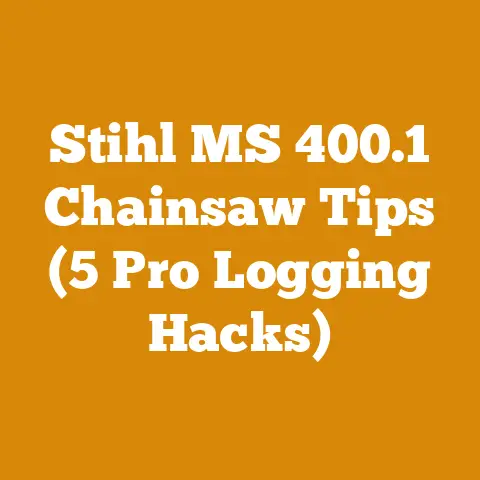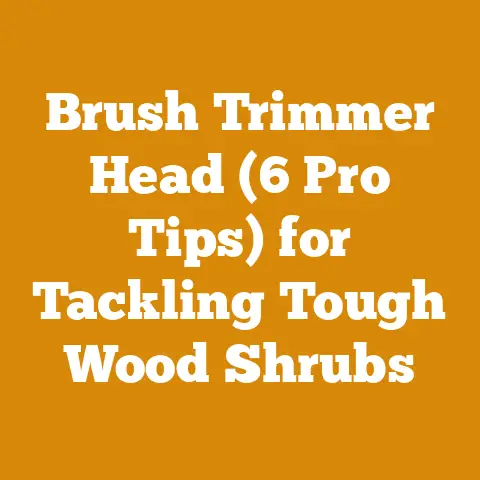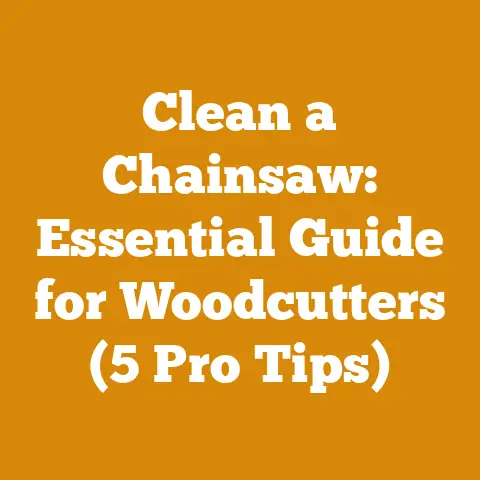Replacing worn sprockets on old chainsaws (Pro Tip)
Have you ever felt the frustration of your chainsaw underperforming, even after sharpening the chain and ensuring proper lubrication?
The culprit might be a worn-out sprocket.
Replacing a worn sprocket is a crucial maintenance task that can significantly improve your chainsaw’s cutting efficiency and prolong its lifespan.
In this guide, I’ll share my decades of experience in logging and wood processing to walk you through the process of replacing worn sprockets on old chainsaws, offering pro tips and insights along the way.
Understanding Chainsaw Sprockets: The Heart of the Cutting System
The sprocket is a critical component in any chainsaw.
It’s the toothed wheel that engages with the chain, transferring power from the engine to the cutting mechanism.
Over time, the constant friction and impact from the chain wear down the sprocket’s teeth, leading to reduced cutting performance and potential damage to the chain.
Why Sprocket Replacement Matters
A worn sprocket can cause several problems:
- Reduced Cutting Speed: Rounded or damaged sprocket teeth can’t grip the chain effectively, leading to slower cutting.
- Chain Slippage: The chain might slip or jump off the bar, posing a safety hazard.
- Increased Chain Wear: A worn sprocket can accelerate wear on the chain, requiring more frequent sharpening and eventual replacement.
- Damage to the Bar: Improper chain tension due to a worn sprocket can damage the guide bar.
- Engine Strain: The engine has to work harder to compensate for the inefficient power transfer, potentially leading to overheating and premature wear.
Think of it like driving a car with worn tires: you’ll experience reduced traction, longer stopping distances, and increased fuel consumption.
Similarly, a worn sprocket compromises your chainsaw’s performance and safety.
Identifying Sprocket Wear: Signs and Symptoms
Knowing when to replace your sprocket is essential for maintaining your chainsaw’s optimal performance.
Here are some telltale signs:
- Visual Inspection: The most obvious sign is visible wear on the sprocket teeth.
Look for rounded, chipped, or excessively worn teeth.
Compare the sprocket to a new one for reference. - Chain Fit: If the chain seems loose or doesn’t fit snugly around the sprocket, it could indicate wear.
- Chain Slippage: As mentioned earlier, frequent chain slippage is a strong indicator of a worn sprocket.
- Uneven Chain Wear: If your chain is wearing unevenly, with some links more worn than others, the sprocket might be the cause.
- Increased Vibration: Excessive vibration during cutting can sometimes be attributed to a worn sprocket.
- The “Sprocket Test”: Remove the chain and try to wiggle the sprocket back and forth.
If you notice significant play or movement, it’s likely worn.
Pro Tip: I always recommend replacing the sprocket after every two or three chain replacements.
This proactive approach helps maintain optimal cutting performance and prevents unexpected breakdowns in the field.
Types of Chainsaw Sprockets
There are two main types of chainsaw sprockets:
- Spur Sprockets: These are one-piece sprockets that are typically found on older or smaller chainsaws.
They are simple, durable, and relatively inexpensive. - Rim Sprockets: These consist of a separate rim that fits onto a clutch drum.
The rim is replaceable, allowing you to replace only the worn part without replacing the entire clutch drum.
Rim sprockets are generally preferred for larger chainsaws due to their improved performance and ease of maintenance.
Spur Sprockets: The Reliable Workhorse
Spur sprockets are known for their simplicity and robustness.
They are a single, solid piece, making them less prone to failure in demanding conditions.
- Pros: Durable, Inexpensive, Easy to maintain.
- Cons: Cannot replace just the rim, Can be less efficient than rim sprockets.
I’ve used spur sprockets extensively on smaller chainsaws for felling small trees and limbing.
Their reliability is a definite advantage in remote locations where access to spare parts might be limited.
Rim Sprockets: Performance and Convenience
Rim sprockets offer a more advanced design with a replaceable rim.
This feature allows you to replace only the worn-out rim, saving you the cost of replacing the entire clutch drum.
- Pros: Replaceable rim, Improved cutting efficiency, Reduced wear on the clutch drum.
- Cons: More complex design, Can be more expensive than spur sprockets.
I prefer rim sprockets on my larger chainsaws used for heavy-duty logging.
The replaceable rim significantly reduces maintenance costs in the long run.
Tools and Materials Needed for Sprocket Replacement
Before you begin the sprocket replacement process, gather the necessary tools and materials:
- New Sprocket: Make sure you have the correct type and size of sprocket for your chainsaw model.
Consult your chainsaw’s manual or a reputable parts dealer. - Sprocket Removal Tool: This tool is specifically designed to remove the sprocket from the crankshaft.
- Piston Stop Tool: This tool prevents the piston from moving while you’re loosening the clutch nut.
- Socket Wrench and Sockets: You’ll need a socket wrench and sockets to remove the clutch cover and clutch nut.
- Screwdrivers: A set of screwdrivers will be helpful for various tasks.
- Pliers: Pliers can be used to remove retaining rings or other small parts.
- Grease: Apply grease to the crankshaft and new sprocket for lubrication.
- Gloves: Wear gloves to protect your hands.
- Safety Glasses: Always wear safety glasses to protect your eyes from debris.
- Clean Rags: Use clean rags to wipe away dirt and grease.
- Chainsaw Manual: Keep your chainsaw manual handy for reference.
Pro Tip: I always keep a well-stocked toolkit specifically for chainsaw maintenance.
This ensures that I have the right tools on hand whenever I need them, saving me time and frustration.
Step-by-Step Guide to Replacing a Chainsaw Sprocket
Now, let’s get to the heart of the matter: replacing the worn sprocket.
Follow these steps carefully for a successful replacement.
Step 1: Prepare the Chainsaw
- Disengage the Chain Brake: Make sure the chain brake is disengaged.
- Remove the Chain and Bar: Remove the chain and guide bar from the chainsaw.
- Clean the Clutch Area: Use a brush or compressed air to remove any dirt, sawdust, or debris from the clutch area.
Step 2: Remove the Clutch Cover
- Locate the Clutch Cover: The clutch cover is typically located on the side of the chainsaw, behind the guide bar.
- Remove the Mounting Hardware: Remove the screws or nuts that secure the clutch cover to the chainsaw.
- Carefully Remove the Clutch Cover: Set the clutch cover aside.
Step 3: Secure the Piston
- Remove the Spark Plug: Disconnect the spark plug wire and remove the spark plug using a spark plug wrench.
- Insert the Piston Stop Tool: Insert the piston stop tool into the spark plug hole.
This will prevent the piston from moving while you’re loosening the clutch nut.
Caution: Be careful not to damage the piston or cylinder wall when inserting the piston stop tool.
Step 4: Loosen the Clutch Nut
- Identify the Clutch Nut: The clutch nut is the nut that holds the clutch drum in place.
- Determine the Thread Direction: Most chainsaws have a left-hand thread on the clutch nut.
This means you’ll need to turn the nut clockwise to loosen it. - Use the Socket Wrench: Use a socket wrench with the appropriate size socket to loosen the clutch nut.
Apply firm, steady pressure.
Pro Tip: If the clutch nut is particularly stubborn, you can try using a penetrating oil to loosen it.
Let the oil soak in for a few minutes before attempting to remove the nut.
Step 5: Remove the Clutch Drum and Sprocket
- Remove the Clutch Nut: Once the clutch nut is loosened, remove it completely.
- Remove the Clutch Drum: Carefully remove the clutch drum from the crankshaft.
- Remove the Sprocket: If you have a spur sprocket, it will come off with the clutch drum.
If you have a rim sprocket, the rim will slide off the clutch drum.
Step 6: Inspect the Clutch Drum and Bearing
- Inspect the Clutch Drum: Check the clutch drum for any signs of wear, damage, or cracks.
If the clutch drum is damaged, it should be replaced. - Inspect the Bearing: Check the bearing inside the clutch drum for smooth operation.
If the bearing is worn or damaged, it should be replaced.
Step 7: Install the New Sprocket
- Apply Grease: Apply a thin layer of grease to the crankshaft and the inside of the new sprocket.
- Install the Sprocket: Slide the new sprocket onto the crankshaft.
If you have a rim sprocket, slide the rim onto the clutch drum first, then install the clutch drum onto the crankshaft.
Step 8: Reinstall the Clutch Nut
- Reinstall the Clutch Nut: Reinstall the clutch nut onto the crankshaft.
- Tighten the Clutch Nut: Tighten the clutch nut using the socket wrench.
Refer to your chainsaw’s manual for the correct torque specification.
Pro Tip: Use a torque wrench to ensure that the clutch nut is tightened to the correct specification.
Overtightening can damage the crankshaft or clutch, while undertightening can cause the clutch nut to loosen during operation.
Step 9: Remove the Piston Stop Tool
- Remove the Piston Stop Tool: Remove the piston stop tool from the spark plug hole.
- Reinstall the Spark Plug: Reinstall the spark plug and connect the spark plug wire.
Step 10: Reinstall the Clutch Cover
- Reinstall the Clutch Cover: Reinstall the clutch cover onto the chainsaw.
- Secure the Clutch Cover: Secure the clutch cover with the screws or nuts.
Step 11: Reinstall the Chain and Bar
- Reinstall the Chain: Reinstall the chain onto the guide bar.
- Reinstall the Bar: Reinstall the guide bar onto the chainsaw.
- Adjust the Chain Tension: Adjust the chain tension according to your chainsaw’s manual.
Step 12: Test the Chainsaw
- Start the Chainsaw: Start the chainsaw and let it idle for a few minutes.
- Check for Proper Operation: Check for proper chain rotation and cutting performance.
- Adjust Chain Tension (If Necessary): Readjust the chain tension if necessary.
Caution: Always wear safety glasses and gloves when operating a chainsaw.
Common Mistakes to Avoid
Replacing a chainsaw sprocket is a relatively straightforward task, but it’s easy to make mistakes.
Here are some common pitfalls to avoid:
- Using the Wrong Sprocket: Make sure you’re using the correct type and size of sprocket for your chainsaw model.
Using the wrong sprocket can damage the chainsaw and void the warranty. - Overtightening the Clutch Nut: Overtightening the clutch nut can damage the crankshaft or clutch.
Use a torque wrench to ensure that the clutch nut is tightened to the correct specification. - Forgetting to Remove the Piston Stop Tool: Forgetting to remove the piston stop tool before starting the chainsaw can damage the piston or cylinder.
- Neglecting to Grease the Sprocket: Applying grease to the crankshaft and sprocket is essential for lubrication and smooth operation.
- Ignoring Wear on Other Components: While you’re replacing the sprocket, take the time to inspect other components, such as the clutch drum and bearing.
Replacing worn parts can prevent future problems.
Pro Tips for Sprocket Replacement
Here are some additional pro tips to help you with sprocket replacement:
- Take Pictures: Before disassembling the chainsaw, take pictures of the clutch area.
This will help you remember how everything goes back together. - Work on a Clean Surface: Work on a clean, well-lit surface to prevent losing small parts.
- Use a Parts Tray: Use a parts tray to keep track of all the small parts.
- Consult Your Chainsaw Manual: Refer to your chainsaw’s manual for specific instructions and torque specifications.
- If in Doubt, Seek Professional Help: If you’re not comfortable replacing the sprocket yourself, take the chainsaw to a qualified technician.
Maintaining Your Chainsaw Sprocket for Longevity
Proper maintenance is key to extending the life of your chainsaw sprocket.
Here are some tips:
- Regular Cleaning: Clean the clutch area regularly to remove dirt, sawdust, and debris.
- Proper Chain Tension: Maintain proper chain tension to prevent excessive wear on the sprocket.
- Proper Lubrication: Use high-quality bar and chain oil to lubricate the chain and sprocket.
- Avoid Overloading the Chainsaw: Avoid overloading the chainsaw, as this can put excessive strain on the sprocket.
- Sharpen the Chain Regularly: A sharp chain reduces the amount of force required to cut, which in turn reduces wear on the sprocket.
Case Study: Sprocket Replacement on a Vintage Chainsaw
I once worked on a vintage chainsaw from the 1970s.
The saw was in rough shape, and the sprocket was severely worn.
The owner had tried to use the saw for firewood cutting, but the chain kept slipping off the bar.
After inspecting the chainsaw, I determined that the sprocket was the primary cause of the problem.
The teeth were rounded and worn, making it difficult for the chain to grip.
I carefully removed the old sprocket and replaced it with a new one.
I also cleaned and lubricated the clutch drum and bearing.
After reassembling the chainsaw, I tested it and found that it was cutting smoothly and efficiently.
The owner was thrilled to have his vintage chainsaw back in working order.
This case study highlights the importance of sprocket replacement in maintaining the performance of even older chainsaws.
A worn sprocket can significantly impact cutting efficiency and safety.
The Environmental Impact of Chainsaw Maintenance
Proper chainsaw maintenance, including sprocket replacement, has a positive impact on the environment.
- Reduced Fuel Consumption: A well-maintained chainsaw operates more efficiently, reducing fuel consumption and emissions.
- Extended Chainsaw Lifespan: Replacing worn parts can extend the life of your chainsaw, reducing the need to purchase new equipment.
- Reduced Waste: By maintaining your chainsaw, you can reduce the amount of waste generated by discarded equipment.
Conclusion: A Small Part, a Big Difference
Replacing a worn sprocket on your chainsaw is a relatively simple and inexpensive task that can significantly improve its performance and extend its lifespan.
By following the steps outlined in this guide, you can confidently tackle this maintenance task and keep your chainsaw running smoothly for years to come.
Remember to prioritize safety, use the correct tools, and consult your chainsaw’s manual for specific instructions.
With a little effort, you can ensure that your chainsaw remains a reliable and efficient tool for all your wood-cutting needs.
And finally, always remember that a sharp chain and a good sprocket are the best friends a logger can have.






